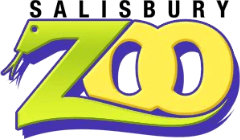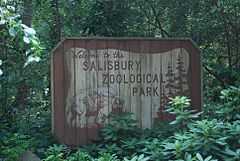Salisbury Zoo
|
Salisbury Zoo logo | |
|
Sign entering the Salisbury Zoo | |
| Date opened | 1954 |
|---|---|
| Location | Salisbury, Maryland, USA |
| Coordinates | 38°21′40″N 75°34′58″W / 38.3610°N 75.5828°WCoordinates: 38°21′40″N 75°34′58″W / 38.3610°N 75.5828°W |
| Land area | 12 acres (4.9 ha)[1] |
| Number of animals | 100+ |
| Annual visitors | 300,000+[2] |
| Memberships | AZA[3] |
| Owner |
City of Salisbury Salisbury Zoo Commission |
| Website |
www |
The Salisbury Zoological Park, commonly referred to as the Salisbury Zoo, is a 12-acre (4.9 ha) zoo located on the Delmarva Peninsula in the Salisbury, Maryland city park. The Salisbury Zoo chooses to mainly house species native to North, South America, and Australia. Its collection of over 100 animals includes wallabys, american alligators, flamingos, North American river otters, ocelots, Patagonian Cavys, red wolves, two-toed sloths, jaguars, llamas, turtles, macaws, rescued raptors and owls, and a spectacled or Andean bear.
The Salisbury Zoo is accredited by the Association of Zoos and Aquariums (AZA), and is one of only a few AZA-accredited zoos that do not charge an entrance fee.
History
The zoo was founded in 1954 with the placement of some animals on permanent display in the city park. Improvements made in the 1970s resulted in the naturalistic enclosures for species native to North, Central, and South America that visitors see today.[4]
The zoo is currently run by a 9 member commission appointed by the Salisbury city council, and is funded partly by the Salisbury Zoo Commission, the City of Salisbury, and the nonprofit group, the Delmarva Zoological Society.[4]
Oldest spectacled bear
The Salisbury Zoo was home to the oldest known captive-born spectacled or Andean bear in the world, as of 2011, named Poopsie.[5] She was born in December 1973 at the Baltimore Zoo and came to the Salisbury Zoo when she was only 7 months old, on July 18, 1974. Poopsie bor two litters of cubs in 1980 and 1981, which she outlived. Spectacled bears generally live to be 25–28 years old. Poopsie turned 37 on December 27, 2010. She was euthanized on November 9, 2011 following arthritic conditions, compromised mobility, and depression.[6]
The future
The zoo is raising money, through its fund-raising nonprofit the Delmarva Zoological Society, Inc. Phase one, which has been completed, was a fundraising campaign for a new Animal Health Clinic, which was required for it to maintain its accreditation with the AZA,[7] and a new Australian exhibit,[8] each cost an estimated $750,000.[9] Phase two of Renew The Zoo is a new Environmental Center.[10] The total fundraising campaign was $3 million.
References
- ↑ "Salisbury Zoo". wicomicotourism.org. Wicomico County Tourism. Retrieved 20 February 2011.
- ↑ Salisbury Zoo Renew The Zoo
- ↑ "List of Accredited Zoos and Aquariums". aza.org. AZA. Retrieved 20 February 2011.
- ↑ 4.0 4.1 "About Us". salisburyzoo.org. Salisbury Zoological Park. Retrieved 20 February 2011.
- ↑ Associated Press (2005-07-13). "Poopsie Recognized as Oldest Captive Andean Bear". WTOP-FM. Retrieved 2011-11-09.
- ↑ Daily Times Salisbury Zoo says goodbye to Poopsie
- ↑ Delmarva Zoological Society Animal Health Clinic
- ↑ Delmarva Zoological Society Discover Australia
- ↑ Severn, Fran (10 February 2011). dead link] "Salisbury Zoo: Already Special and Planning to be More". chesapeakelifemag.com. Chesapeake Life magazine. Retrieved 20 February 2011.
- ↑ Delmarva Zoological Society Environmental Center
External links
| ||||||||||||||
| ||||||||||||||||||||||||||

